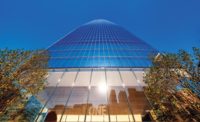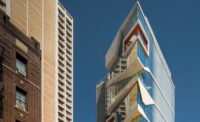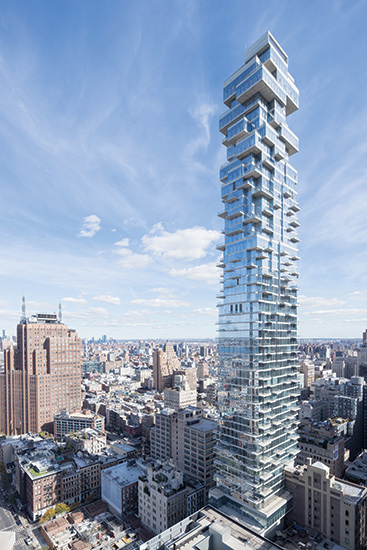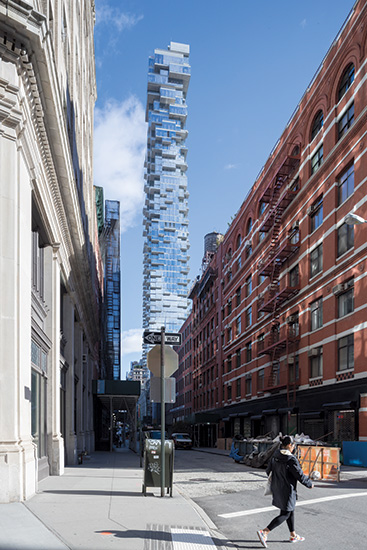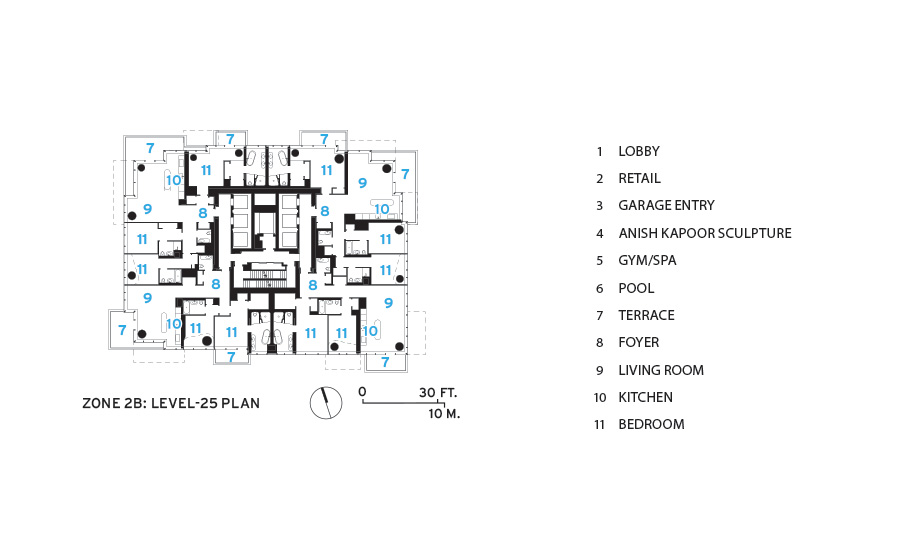56 Leonard Street by Herzog & de Meuron
New York City

56 Leonard Street, in the Tribeca neighborhood of Lower Manhattan, is an assemblage of glass-ensclosed volumes and cantilevering terraces, with the most exuberant projections occurring near its top.
Photo © Iwan Baan

56 Leonard Street, in the Tribeca neighborhood of Lower Manhattan, is an assemblage of glass-ensclosed volumes and cantilevering terraces, with the most exuberant projections occurring near its top.
Photo © Iwan Baan

Views of 56 Leonard should remain unobstructed from the nearby streets since it is surrounded by a height-restricted district.
Photo © Iwan Baan

Residents and visitors enter the building through a sober lobby with walls clad in lozenge-shaped black granite tiles.
Photo © Iwan Baan

The amenity spaces continue the dark palette. The pool has black terrazzo floors, treated to make them slip resistant.
Photo © Alexander Severin

Floor-to-ceiling window walls wrap the entire perimeter of every apartment, providing spectacular views, especially from the upper floors.
Photo © Iwan Baan

All the units have projecting balconies, but none line up with those on the floors above or below.
Photo © Iwan Baan

















Architects & Firms
For quite a while, it seemed as if Herzog & de Meuron’s 56 Leonard Street project—a 57-story residential tower in the Tribeca neighborhood of Lower Manhattan—would never get built. For four years during the financial crisis, construction was at a total standstill. But now, nearly a decade after ground was broken, the structure, made up of stacked glassenclosed volumes and projecting terraces, is almost finished, and residents are starting to move in.
Additional Content:
Credits & specifications
Sidebar: The Skinny on the Structure
Ascan Mergenthaler, a Herzog & de Meuron partner, says that the idea behind the unusual cantilevering geometry was not to defy gravity, but to design the units from the inside out and then express the individual apartments and their generous outdoor spaces in the form of the architecture.
Although 56 Leonard has been referred to as “Jenga-like” countless times in the press, the result is an assemblage that appears carefully balanced in equilibrium rather than on the verge of toppling over. Its protruding elements recall the famous image of a disembodied hand sliding one apartment into a model of Le Corbusier’s Unité d’Habitation in Marseille, France. This sensation of pushing and pulling, together with its reflective glass envelope, give the building a compelling chimera-like quality, with features that seem to change depending on one’s vantage point, the weather conditions, or the time of day.
The 831-foot-tall reinforced concrete structure contains only 145 condominiums, ranging from 650-square-foot studios to penthouse apartments of more than 6,000 square feet. Although no two floors within the building are exactly the same, the unit types are organized into seven zones that can be discerned from the outside if one carefully studies the shift in the patterns of the extending balconies. The most exuberant projections occur near the top.
But even if the expressive crown refers to an earlier time of New York’s classical skyscrapers with silhouetted spires, Herzog & de Meuron’s building, which has a width-to-height ratio of about 1:10.5, is also representative of an emerging New York typology. This is the tall, slim, luxury residential tower with spectacular city views. In the case of 56 Leonard, depending on an apartment’s position and orientation within the structure, occupants look out over the surrounding neighborhood and toward the Hudson and East rivers, Wall Street and the World Trade Center, and, in the distance, Midtown. These vistas—as well as views of the tower from elsewhere in Manhattan—could actually remain unobstructed due to the peculiarities of the 12,500-square-foot parcel, which is surrounded by a mostly low-rise, height-restricted historic district. The 56 Leonard lot, previously owned by the New York Law School, was exempt from these limits. And when the developer, Alexico Group, purchased it in 2006, it also acquired the air rights transferred from the school’s adjacent properties.
It should be noted that Leonard Street’s peers in slenderness, such as the completed 432 Park by Rafael Viñoly, or under-construction towers like SHoP’s 111 West 57th and Jean Nouvel’s 53 West 53rd, have sparked criticism on many fronts. One complaint is that the apartments’ uber-wealthy investors will rarely occupy them, leaving the buildings—most of which are concentrated around the southern end of Central Park—empty and lifeless.
Both Herzog & de Meuron and Alexico take pains to distinguish their tower from their uptown super-skinny cousins. The apartments at 56 Leonard “are not safe deposit boxes in the sky,” says Mergenthaler. “The majority of the owners are really living there.” Many of the buyers are moving from elsewhere in Tribeca, says Izak Senbahar, Alexico’s president. He points out that the neighborhood has a paucity of buildings with amenities like those at 56 Leonard, which include parking, a 75-foot-long lap pool, and a movie screening room. Though construction is still not entirely complete, about 45 apartments are already occupied.
Most of these residents may well be actual New Yorkers, but they are without question very affluent ones. All except two of 65 Leonard’s units have been sold, fetching an average of $3,250 per square foot, according to one local real-estate publication. All that remains is a 15th-floor one-bedroom, with an asking price of just over $3 million, and a 3,700-square-foot penthouse listed at $17.75 million.
To reach the apartments, residents and visitors travel through a very sober lobby. It has walls clad in lozenge-shaped black granite tiles, exposed concrete slab as the ceiling, and a light gray terrazzo floor. But once 56 Leonard’s denizens ascend, daylight and the dramatic views take command. Inside the units, the ceilings are a minimum of 11 feet high, while some penthouses have almost 19-foot ceilings. Finishes are primarily soft-toned and lightreflective, including white oak floors, acid-etched mirrored kitchen cabinets, and bathroom walls covered in white marble. The insulated glazing, which stretches from slab to slab and around the entire perimeter, includes two different coatings to help control heat gain and glare. (It is up to the owners to install the window treatments they will presumably want for privacy.)
One of the project’s rare missteps is a planned public art piece by Anish Kapoor. As shown in renderings, the sculpture will be an unfortunate adaptation of his beanlike Cloud Gate at Chicago’s Millennium Park. The aim is to help anchor the building to the ground, says Senbahar. But it is hard to imagine how the mirrored sculpture will accomplish that: the piece will be awkwardly lodged under one corner at street level, appearing as though it is slightly deflated from the weight of the structure above.
Fortunately, most people will be able to avoid the Kapoor sculpture and admire the building as an arresting addition to Lower Manhattan’s skyline.
Back to Continuing Education: Tall Buildings
Video © EarthCam
Sidebar: The Skinny on the Structure

The basic structural elements for 56 Leonard sound conventional enough: the building has a concrete core and concrete flat-plate slabs supported by concrete columns and shear walls. But though it sounds typical, it was highly challenging to engineer and construct. Its scheme of stacked and shifting volumes meant that no two consecutive floors are the same. “It’s a monumental sculpture,” says Silvian Marcus, director of building structures at WSP|Parsons Brinckerhoff, the project’s structural engineer. Because the columns don’t align from level to level, Marcus and his team designed “walking columns.” These are one- or two-story structural walls that transfer loads between floors. To support the building’s many cantilevers, in most cases the engineers used the thickness of the slabs, but for some they added beams. The longest cantilevers—which project as much as 25 feet— required Vierendeel trusses extending over two stories. To significantly increase the rigidity of the structure, the engineers connected the columns to the core at mechanical floors 32 and 46 with outriggers and belt walls that wrap the perimeter. Despite such measures, the slender tower—with an aspect ratio of about 1:10.5— still has a tendency to sway. But it includes a liquid slosh damper at the top. This tank, measuring 32 by 36 feet by 10 feet tall, is filled with water that moves to counteract the sometimes perceptible wind-induced “acceleration.” The device is not a safety or code requirement, says Marcus—it is purely for occupant comfort. “The code does not care about feelings,” he says.
CreditsArchitect: Herzog & de Meuron Partners: Jacques Herzog, Pierre de Meuron, Ascan Mergenthaler (Partner in Charge) Project Team: Philip Schmerbeck (Associate, Project Director), Mehmet Noyan (Associate, Project Manager), Vladimir Pajkic (Associate) Caroline Alsup, Mark Chan, Simon Filler, Dara Huang, Sara Jacinto, Jin Tack Lim, Mark Loughnan, Jaroslav Mach, Donald Mak (Associate), Hugo Miguel Moura, Jeremy Purcell, Chantal Reichenbach, James Richards, Heeri Song, Charles Stone, Kai Strehlke, Zachary Martin Vourlas, Jason Whiteley, Sung Goo Yang, Daniela Zimmer, Christian Zöllner, Iwona Boguslawska, Martin Raub, Josh Helin, Joem Elias Sanez
Executive Architect: Goldstein, Hill & West Architects
Consultants: Cosentini Associates (mechanical); WSP|Parsons Brinckerhoff (structural); Schwinghammer Lighting (lighting); Gordon H. Smith Corporation (facade)
Construction Manager: Lend Lease
Client: Alexico Group
Size 490,000 square feet
Cost: withheld
Projected completion date: June 2017
|
SpecificationsWindow walls Enclos Operable windows Schüco Wood floors RQ Floors Lighting Maison Lucien Gau; Patrick Nash Design
|



